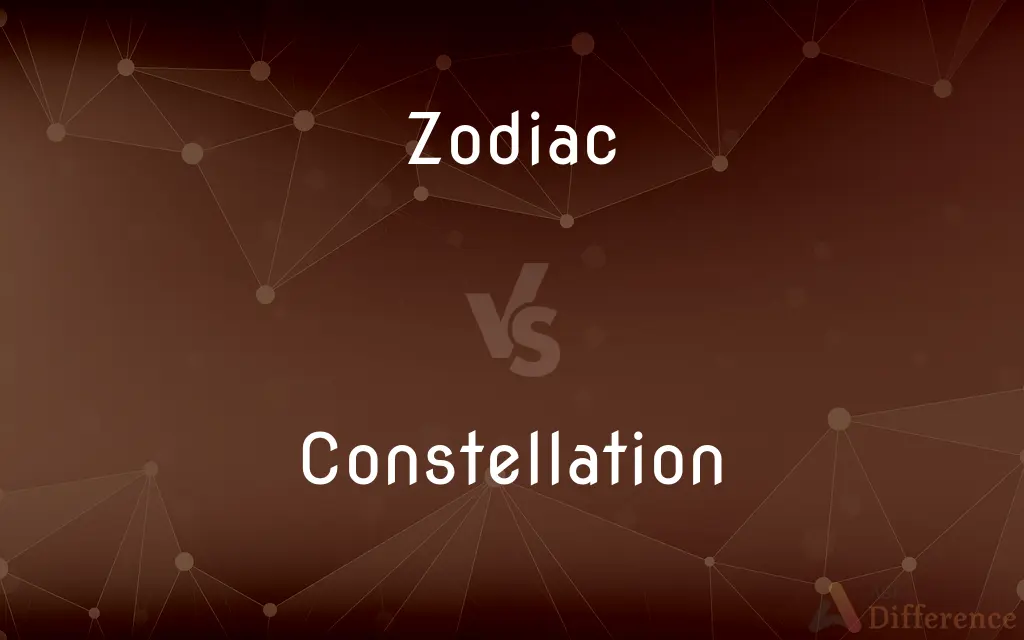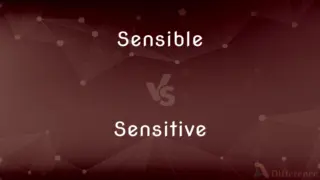Zodiac vs. Constellation — What's the Difference?
By Tayyaba Rehman & Maham Liaqat — Updated on March 28, 2024
The Zodiac refers to 12 specific constellations along the ecliptic, while a constellation is a group of stars forming a recognizable pattern.

Difference Between Zodiac and Constellation
Table of Contents
ADVERTISEMENT
Key Differences
The Zodiac comprises twelve constellations that lie along the ecliptic, the apparent path of the Sun across the sky over the course of the year. These include Aries, Taurus, Gemini, and so on, representing sectors of the sky through which the Sun, Moon, and planets move. In contrast, a constellation is a broader term for any of the 88 recognized star patterns identified by astronomers, not limited to the ecliptic path. While Zodiac constellations are part of this larger group, they are specifically associated with astrology and the calendar.
Zodiac constellations have significant cultural and astrological implications, historically used to predict events and individual characteristics based on celestial movements. Constellations outside the Zodiac, however, are primarily used for navigational and astronomical purposes, without the astrological associations. This distinction highlights the unique role Zodiac constellations play in blending scientific observation with cultural and spiritual meanings.
The concept of the Zodiac is deeply embedded in multiple cultures, with its origins tracing back to ancient civilizations that used these constellations to develop calendars and organize time. Meanwhile, the cataloging of all constellations, including those outside the Zodiac, is a more recent astronomical practice aimed at standardizing celestial mapping. This effort underscores the scientific approach to understanding the stars, in contrast to the Zodiac's more mystical and predictive uses.
Each Zodiac constellation corresponds to a specific time period within the year, dictating astrological signs for individuals born under those dates. Other constellations, while they may be visible at certain times of the year, do not have the same direct influence on horoscopes and personal traits ascribed by astrology. This personal aspect of the Zodiac differentiates it from the general study of constellations, which focuses on the physical and spatial properties of star patterns.
Understanding the difference between the Zodiac and general constellations offers insight into how human cultures have interacted with the night sky, from navigation and timekeeping to spiritual and predictive purposes. The Zodiac's role in astrology represents a human attempt to find meaning and guidance in the stars, a contrast to the purely scientific classification and study of constellations.
ADVERTISEMENT
Comparison Chart
Definition
12 specific constellations along the ecliptic.
Any of the 88 recognized patterns formed by groups of stars.
Purpose
Astrological predictions, cultural significance.
Navigation, astronomical observation, cultural stories.
Association
Astrology, horoscopes, birth signs.
Astronomy, celestial navigation, mythology.
Number
12
88
Cultural Significance
Deeply intertwined with human history and astrology.
Varied, with many constellations having unique myths and stories.
Examples
Aries, Taurus, Gemini, etc.
Orion, Ursa Major, Andromeda, etc.
Visibility
Along the ecliptic, changing seasonally.
Varies widely, some are circumpolar, others seasonal.
Use in Timekeeping
Historically used to develop calendars.
Used for celestial navigation and orientation.
Compare with Definitions
Zodiac
Directly related to the ecliptic path of the Sun and planets.
The movement of planets through the Zodiac constellations is used in horoscope readings.
Constellation
Includes 88 official patterns recognized by astronomers.
The Southern Cross, or Crux, is a constellation not visible from the Northern Hemisphere.
Zodiac
Aligns with the Earth's orbit around the Sun, marking astrological signs.
The Zodiac sign Virgo is associated with those born from August 23 to September 22.
Constellation
Used for navigation and as a tool in astronomy to map the night sky.
Sailors have historically used the North Star in the constellation Ursa Minor for navigation.
Zodiac
Has historical significance in various cultures for timekeeping and predictions.
Ancient Babylonians developed the Zodiac system that is still in use today.
Constellation
Often associated with myths and legends across different cultures.
The constellations of the Zodiac are also imbued with stories from ancient astrology.
Zodiac
Used in astrology to predict personality traits and life events.
Astrologers claim that being born under the Scorpio Zodiac sign imparts intensity and passion.
Constellation
A group of stars forming a recognizable pattern, named after objects, animals, or mythological figures.
Orion, named after the hunter in Greek mythology, is one of the most recognizable constellations.
Zodiac
A cycle of twelve constellations through which the Sun appears to move throughout the year.
Leo is one of the Zodiac constellations, representing those born from July 23 to August 22.
Constellation
Varied in visibility throughout the year and from different parts of the Earth.
The constellation Cassiopeia is visible year-round in the Northern Hemisphere.
Zodiac
In astrology, this band divided into 12 equal parts called signs, each 30° wide, bearing the name of a constellation for which it was originally named but with which it no longer coincides owing to the precession of the equinoxes.
Constellation
A constellation is an area on the celestial sphere in which a group of visible stars forms a perceived outline or pattern, typically representing an animal, mythological person or creature, or an inanimate object.The origins of the earliest constellations likely go back to prehistory. People used them to relate stories of their beliefs, experiences, creation, or mythology.
Zodiac
The zodiac is an area of the sky that extends approximately 8° north or south (as measured in celestial latitude) of the ecliptic, the apparent path of the Sun across the celestial sphere over the course of the year. The paths of the Moon and visible planets are also within the belt of the zodiac.In Western astrology, and formerly astronomy, the zodiac is divided into twelve signs, each occupying 30° of celestial longitude and roughly corresponding to the star constellations: Aries, Taurus, Gemini, Cancer, Leo, Virgo, Libra, Scorpio, Sagittarius, Capricorn, Aquarius, and Pisces.These astrological signs form a celestial coordinate system, or even more specifically an ecliptic coordinate system, which takes the ecliptic as the origin of latitude and the Sun's position at vernal equinox as the origin of longitude.
Constellation
A group of stars forming a recognizable pattern that is traditionally named after its apparent form or identified with a mythological figure.
Zodiac
(Astronomy) A band of the celestial sphere extending about 8° to either side of the ecliptic that represents the path of the principal planets, the moon, and the sun.
Constellation
A grouping of stars on the celestial sphere perceived as a figure or design, especially one of the 88 recognized groups named after characters from classical Greek and Roman mythology as well as various common animals and objects.
Zodiac
A diagram or figure representing the zodiac.
Constellation
An area of the celestial sphere occupied by one of the 88 recognized constellations.
Zodiac
A complete circuit; a circle.
Constellation
The configuration of planets at the time of one's birth, regarded by astrologers as determining one's character or fate.
Zodiac
(astrology) The belt-like region of the celestial sphere approximately eight degrees north and south of the ecliptic which include the apparent path of the sun, moon, and visible planets.
Constellation
A gathering or assemblage, especially of prominent persons or things
The symposium was attended by a constellation of artists and writers.
Zodiac
(astrology) The twelve equal divisions of the zodiacal region into signs or houses, each named for a prominent constellation in the region.
Constellation
A set or configuration, as of related items, properties, ideas, or individuals
A constellation of demands ranging from better food to improved health care.
A constellation of feelings about the divorce.
Zodiac
(astronomy) The ecliptic: the belt-like region of the celestial sphere corresponding to the apparent path of the sun over the course of a year.
Constellation
(astronomy) An asterism, an arbitrary formation of stars perceived as a figure or pattern, or a division of the sky including it, especially one officially recognised by astronomers.
Zodiac
Any of various astrological systems considered similar to the above.
Constellation
Any of the 88 regions of the sky officially recognized by the IAU, including all stars and celestial bodies in the region.
Zodiac
(countable) A circle decorated with the signs of the zodiac.
Constellation
An image associated with a group of stars.
Zodiac
An imaginary belt in the heavens, 16° or 18° broad, in the middle of which is the ecliptic, or sun's path. It comprises the twelve constellations, which one constituted, and from which were named, the twelve signs of the zodiac.
Constellation
(astrology) The configuration of planets at a given time (notably of birth), as used for determining a horoscope.
Zodiac
A girdle; a belt.
By his side,As in a glistering zodiac, hung the sword.
Constellation
(figuratively) A wide, seemingly unlimited assortment.
A constellation of possibilities.
Zodiac
A belt-shaped region in the heavens on either side to the ecliptic; divided into 12 constellations or signs for astrological purposes
Constellation
(spaceflight) A fleet of satellites of the same purpose such as the set of GPS satellites, or Iridium satcom fleet.
Zodiac
(astrology) a circular diagram representing the 12 zodiacal constellations and showing their signs
Constellation
A configuration or grouping.
Constellation
A network of connections that exists between people who are in polyamorous relationships, for example between one person, their partner, and that person's partner.
Constellation
A cluster or group of fixed stars, or division of the heavens, designated in most cases by the name of some animal, or of some mythologial personage, within whose imaginary outline, as traced upon the heavens, the group is included.
The constellations seem to have been almost purposely named and delineated to cause as much confusion and inconvenience as possible.
Constellation
An assemblage of splendors or excellences.
The constellations of genius had already begun to show itself . . . which was to shed a glory over the meridian and close of Philip's reign.
Constellation
Fortune; fate; destiny.
It is constellation, which causeth all that a man doeth.
Constellation
An arrangement of parts or elements;
The outcome depends on the configuration of influences at the time
Constellation
A configuration of stars as seen from the earth
Common Curiosities
Can a constellation be part of the Zodiac?
Yes, but only the specific twelve constellations that lie along the ecliptic path are considered part of the Zodiac.
How are new constellations named?
New constellations are not named in modern times; the 88 constellations recognized today were officially defined by the International Astronomical Union in the early 20th century.
What is the difference between the Zodiac and constellations?
The Zodiac refers specifically to twelve constellations along the ecliptic path, associated with astrology, while constellations are any of the 88 star patterns recognized in astronomy.
Are Zodiac constellations visible all year round?
No, each Zodiac constellation is best visible at certain times of the year, as the Earth orbits the Sun and changes the night sky view.
Why are there only 12 Zodiac constellations?
The 12 Zodiac constellations correspond to the 12 segments of the ecliptic divided by the Babylonians, each associated with a month in the year.
What is the purpose of constellations?
Constellations serve various purposes, including navigation, organizing the night sky for astronomers, and cultural storytelling.
Do all cultures recognize the same constellations?
While many cultures share some constellations, different cultures have historically identified and named constellations based on their own myths and stories.
How do Zodiac signs relate to individual personalities in astrology?
In astrology, one's Zodiac sign, determined by the position of the Sun at birth, is believed to influence personality traits and destiny.
How did ancient cultures use the Zodiac?
Ancient cultures used the Zodiac for calendrical purposes, to track the seasons, and for astrological predictions and interpretations.
What constellation is not part of the Zodiac?
Constellations like Orion, the Big Dipper (part of Ursa Major), and the Southern Cross (Crux) are not part of the Zodiac.
How do astronomers view constellations differently from astrologers?
Astronomers view constellations as segments of the sky to aid in the mapping and naming of celestial objects, while astrologers use them to interpret human affairs and natural phenomena.
What's the significance of the ecliptic in defining the Zodiac?
The ecliptic is significant as it marks the apparent path of the Sun through the sky, upon which the Zodiac constellations are located, playing a key role in astrological traditions.
Is there a scientific basis for astrology?
While the movement and position of celestial bodies are scientifically measurable, mainstream science does not support astrology's claims that these influence individual traits or destinies.
Why do some people identify with their Zodiac sign?
Many find astrological descriptions to be reflective of their personality or life experiences, using astrology as a tool for self-reflection and understanding.
Can the same star belong to more than one constellation?
No, each star is officially assigned to a single constellation by the International Astronomical Union, though in historical and cultural contexts, stars may have been shared among constellations.
Share Your Discovery

Previous Comparison
Dad vs. Father
Next Comparison
Sensible vs. SensitiveAuthor Spotlight
Written by
Tayyaba RehmanTayyaba Rehman is a distinguished writer, currently serving as a primary contributor to askdifference.com. As a researcher in semantics and etymology, Tayyaba's passion for the complexity of languages and their distinctions has found a perfect home on the platform. Tayyaba delves into the intricacies of language, distinguishing between commonly confused words and phrases, thereby providing clarity for readers worldwide.
Co-written by
Maham Liaqat













































